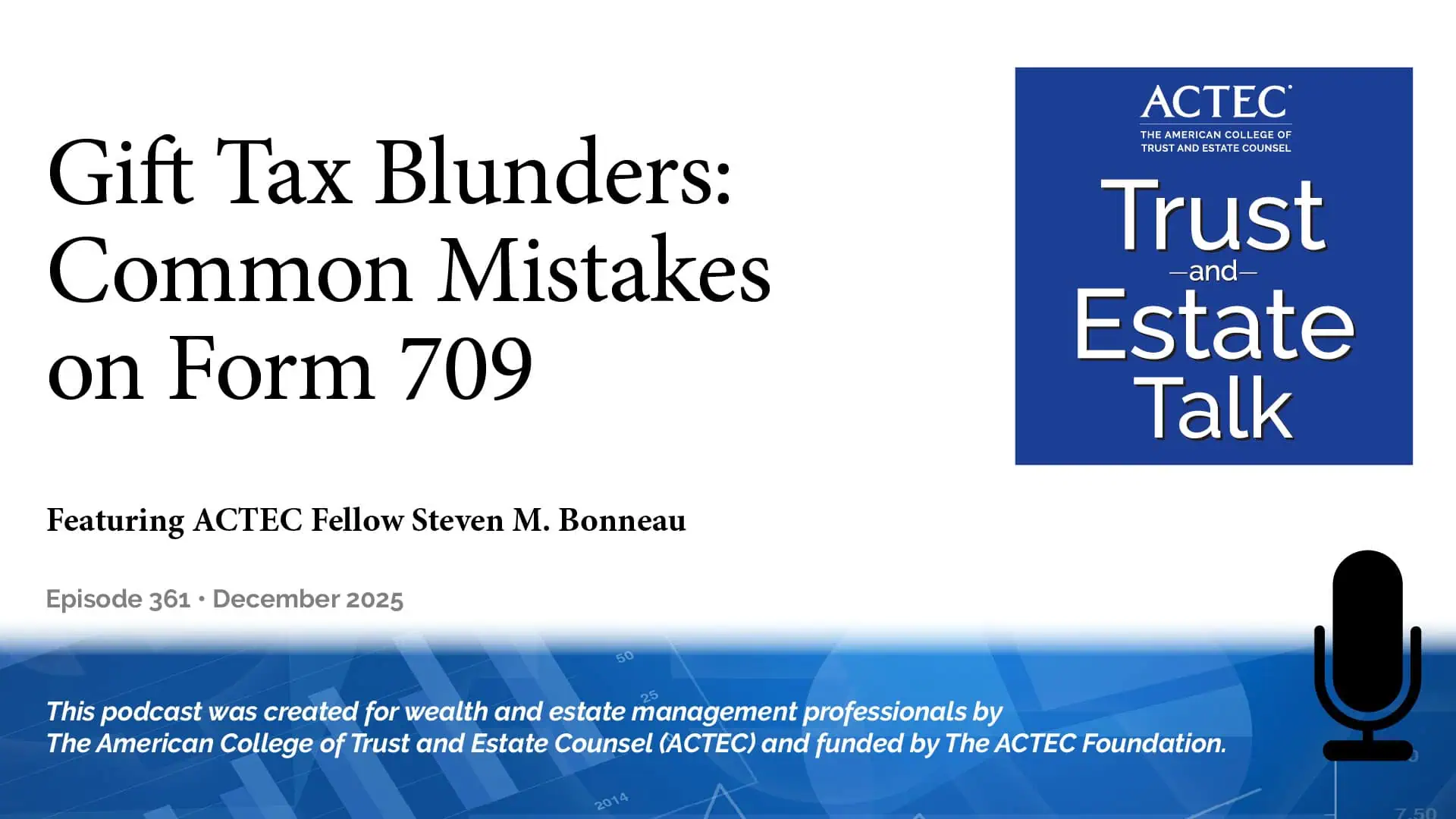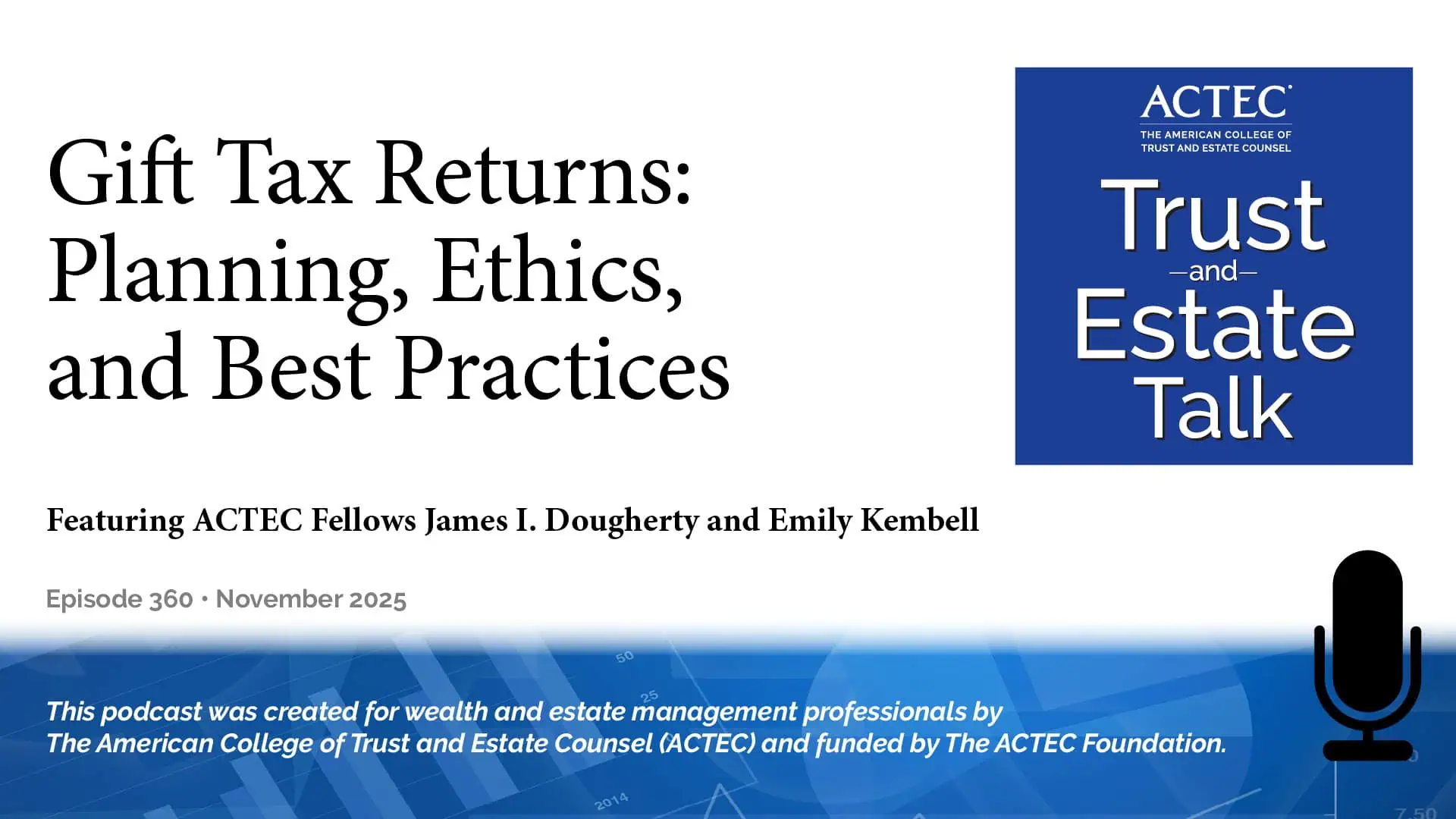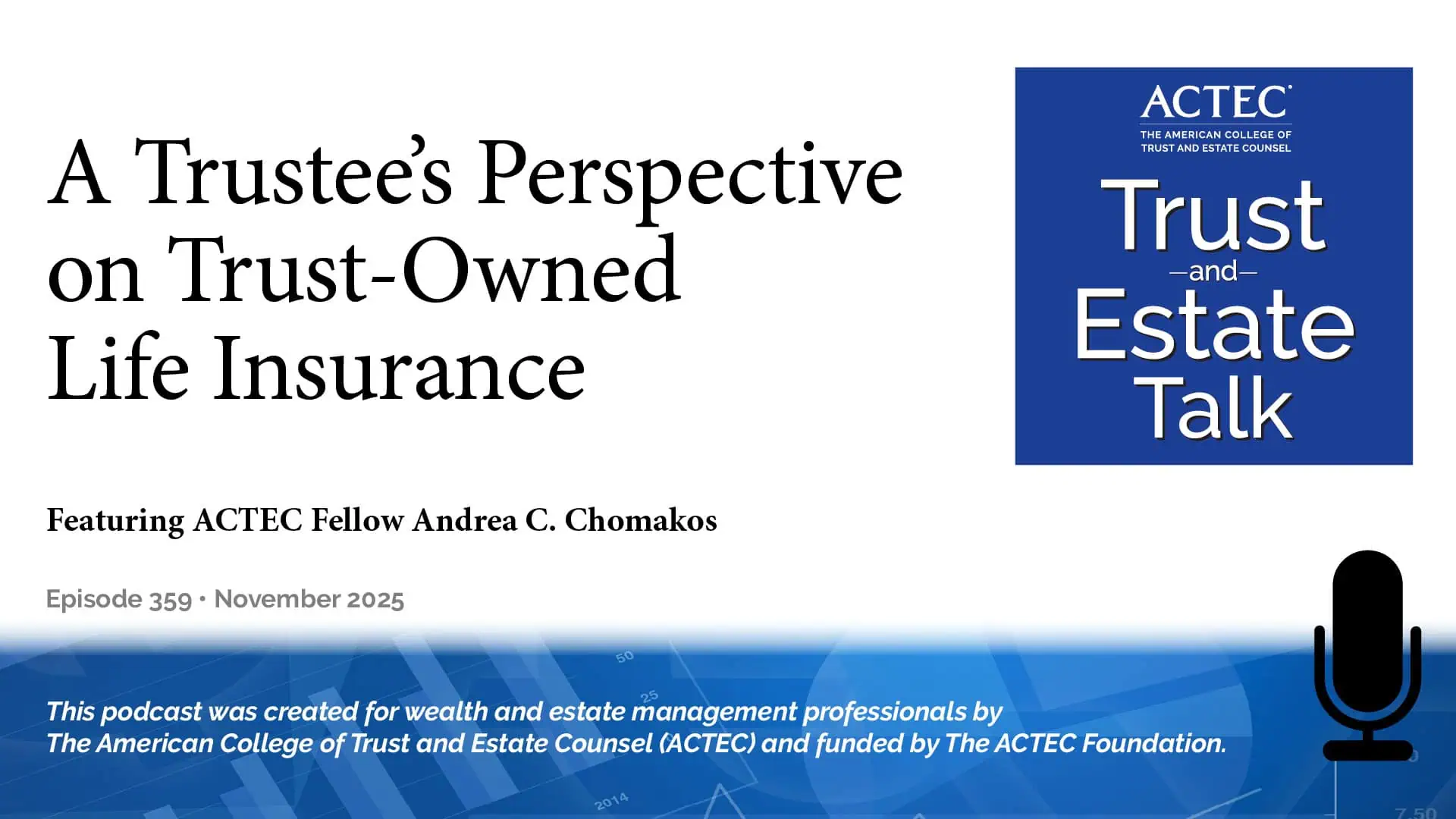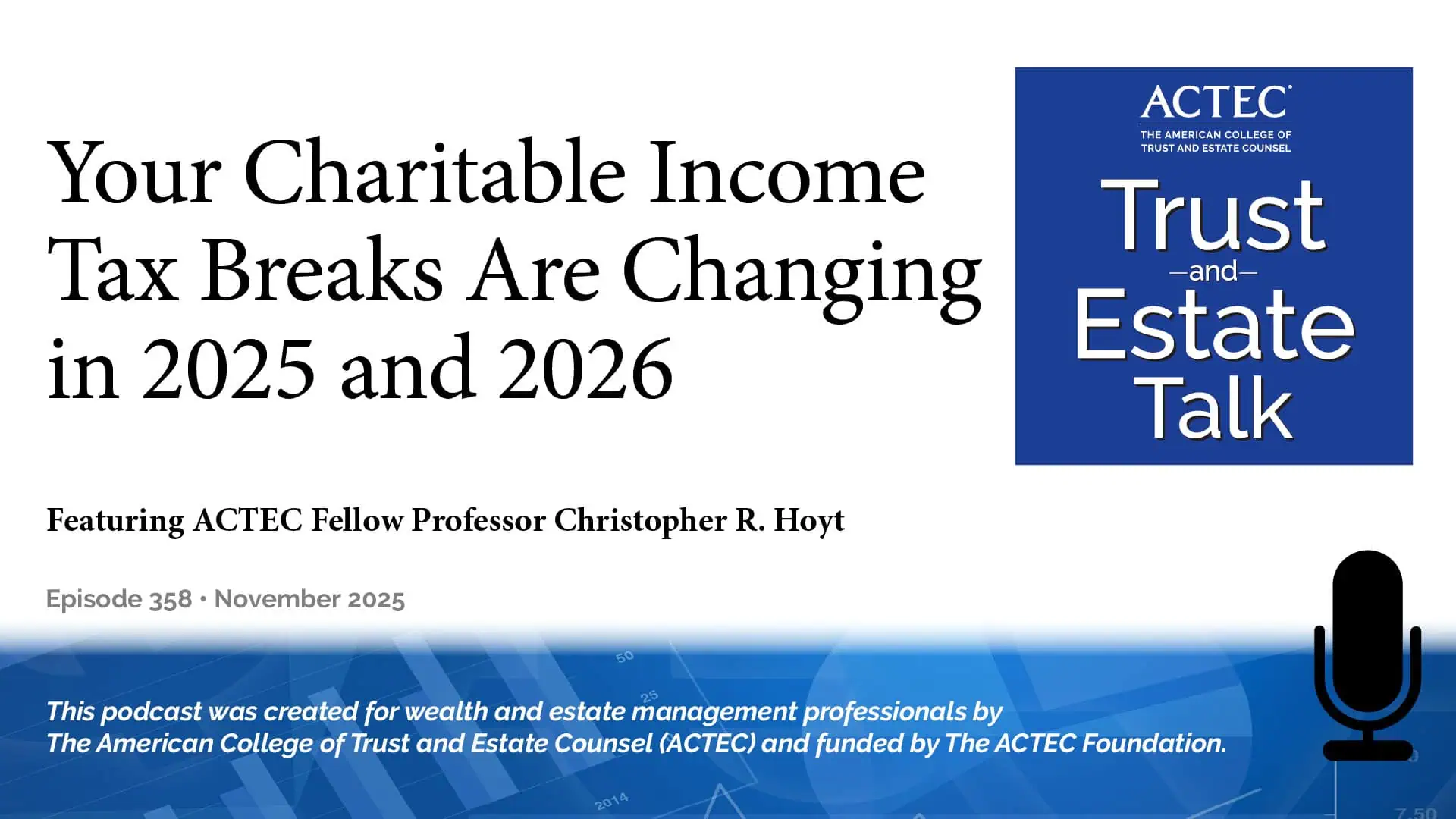A Trustee’s Perspective on Trust-Owned Life Insurance
“A Trustee’s Perspective on Trust-Owned Life Insurance,” that is the subject of today’s ACTEC Trust and Estates Talk.
Transcript/Show Notes
This is ACTEC Fellow John Challis of St. Louis, Missouri.
Life insurance is not just a product, it is a valuable asset to both the insured and the insured’s beneficiaries. Insurance issuers have developed more policy offerings that include sophisticated investments in support of the policy performance, as well as policies that provide benefits for long-term care and assisted living.
ACTEC Fellow Andrea Chomakos of Charlotte, North Carolina, joins us today to share her expertise as a fiduciary counsel Fellow to understand the perspective of a trustee of an Irrevocable Life Insurance Trust, or ILIT, which is critical to advising clients who are establishing these trusts as well as working with trustees on the administration of these trusts. Welcome, Andrea.
Calculating and Tracking Hanging Withdrawal Rights
Andrea Chomakos: As the saying goes, “nothing is certain in life except death and taxes,” and no one looks forward to either of these events. I would suspect that life insurance may be next on the list of least desirable topics at a dinner party conversation, and that goes for trust and estate professionals as well. But I hope to bring some enthusiasm along with tips and thought-provoking issues when dealing with life insurance and irrevocable trusts, also known as ILITs. So let’s jump in.
Grantor vs. Non-Grantor Trusts: The First Critical Decision
The first thing when considering creating an ILIT that any estate planning attorney needs to consider and discuss with their clients is whether that trust will be drafted to be classified as a grantor trust for income tax purposes or non-grantor trust. Commonly, ILITs are drafted as grantor trusts because, first, the trust accounting income that is, for example, interest and dividends earned in the trust is to be used to pay the insurance premiums without the consent of an adverse party. Because of those circumstances, the trust will be classified as a grantor trust under Internal Revenue Code Section 677.
Next, transactions between the insured policy owner and the trust are disregarded for income tax purposes in a grantor trust and, as a result, also exempt from the transfer value rules of Internal Revenue Code Section 101. And then, next, if the trust only holds a life insurance policy, then there is nominal, if any, income tax consequences to the grantor, so the decision is really inconsequential.
Key Considerations for Non-Grantor ILITs
However, there are also times when life insurance is owned in an irrevocable trust that holds other assets, including income-producing assets, in those circumstances, a grantor may not want to have the trust classified as grantor for income tax purposes. If the trust is classified as non-grantor, then the trustee will need to consider the following:
- First, how to track the payment of premiums from principal cash versus income cash. And here, when I’m talking about income and principal, I’m talking about it from a trust or fiduciary accounting concept, not taxable income.
- Next, whether the trust has taxable income and is required to file a tax return and potentially pay income taxes.
- And the third is the implications of any transaction involving a policy. That includes a sale, a surrender, and also the implications of Section 101, the transfer for value rules when it comes to that policy.
There’s a lot of things to consider on this pretty basic initial question.
Crummey Withdrawal Rights: More Than a Boilerplate Provision
The next thing to consider in creating and drafting an ILIT [is] what are referred to as the “crummey withdrawal rights”. Those are the withdrawal rights that almost every irrevocable trust includes and virtually every ILIT also includes. And that is the right to the provision in the trust that gives the trustee the direction to give beneficiaries the right to withdraw those annual gifts that are made to the trust so that those annual gifts made to the trust don’t use the grantor’s lifetime exemption, instead qualify for the annual gift tax exclusion.
Most people drafting attorneys view ILITs and irrevocable trust with crummey withdrawal rights. That’s a pretty basic, no-brainer type of provision; it’s included and we don’t give a whole lot of thought to it. But I would caution a few things to consider, particularly when it comes to an ILIT, because the devil is always in the details.
Who Holds Withdrawal Rights and Why It Matters
First, who is included in the list of beneficiaries with those crummey withdrawal and demand rights? If the ILIT is created and it’s anticipated that the contributions needed to fund that trust are going to be fairly significant because the premiums are front-end loaded, for example. And the grantor’s family line is what I call relatively thin, maybe there is one or just two children and not very many grandchildren, then the contributions and the gifts to the trust may be decreased by the annual exclusion amount but still have a residual amount that uses the grantor’s lifetime exemption. So some attorneys consider adding additional people who are not remainder beneficiaries of the trust to the class of people with withdrawal rights. That’s really something to consider, maybe look at whether or not there’s any risk there from the IRS perspective or from a fiduciary perspective.
Drafting Withdrawal Rights: Generational vs. Pot-Class Approaches
The next thing to consider is how are the withdrawal rights drafted as it pertains to the rights of descendants? Is it a pot class, so all descendants will get a withdrawal right? Or is it tiered generationally? So that first you’re looking at children and then if there’s excess contributions to the trust in excess of the annual gift tax exemption amount, then you go on to grandchildren. So that’s another way to look at it and from a fiduciary perspective, I would advocate for the latter so that it’s easier to calculate and give those notices.
Determining When Gifts Trigger Withdrawal Rights
And then the third thing — and this is something that when I was a drafting attorney, I looked at and in the middle of my career changed how I drafted — that is looking at how the trustee is going to determine whether a gift to the trust actually triggers a withdrawal right. And that pertains to situations when the grantor may be making annual exclusion gifts outside of the trust. Is the trustee put on notice of those? How are they supposed to take those into consideration? Because the annual gift tax exclusion is applied chronologically to gifts made by the grantor throughout the year. So it may be that for gifts made to a trust later in the year, you don’t know: has the grantor made gifts earlier in the year? Does this gift to the trust trigger that withdrawal right? How do you know? So those are things that I would just bring to the forefront, they’re addressed in more in depth in my white paper, which will be included in the materials along with this podcast. Take a look at those for more information there.
The “Hanging Withdrawal Right” Explained
Now, speaking of withdrawal rights, probably the trickiest, most complex issue in any trust that has withdrawal rights — which includes, as I said, almost virtually every ILIT — is what’s called the “hanging withdrawal right.” The hanging withdrawal right is included because a withdrawal right held by a beneficiary is considered a general power of appointment under Code Section 2514. The lapse of a withdrawal right, “a lapse being the failure to exercise the withdrawal right within the period that the withdrawal right is open,” a lapse of a withdrawal right, which is a lapse of a general power of appointment, is treated as a gift by the person holding that withdrawal right and power of appointment back to the trust. However, a lapse will only trigger that resulting gift by the holder of the withdrawal right if the withdrawal right exceeds the greater of $5,000 and 5% of the value of the trust property.
That’s a mouthful. That is, again, a complex calculation and tracking that needs to be done. It’s addressed in more detail in my white paper and I would also refer you to an article by Lou Harrison, who was an ACTEC Fellow out of Chicago, wrote an excellent article on this back in the 90s, and yes, three decades later, 30 years later, that article is still on point because nothing has changed much with hanging withdrawal rights.
Calculating and Tracking Hanging Withdrawal Rights
The thing to consider here, I would say, is from a trustee’s perspective. How do you calculate that hanging withdrawal right? How do you determine whether it applies and then tracking it, because what that hanging withdrawal right means is that beneficiary continues to have the right to withdraw the amount of that hang, what I refer to as the excess amount, the hang, for succeeding years until such time as it is exhausted. It is an annual calculation; if there’s gifts made to the trust in the next year, you have to calculate it again and potentially compound the hang until such period of time as it can get exhausted by either no gifts being made to the trust or, remember how the calculation works, it’s the lesser of $5,000 and 5% of the value of the trust property. As the value of the trust property increases, the amount of that hang can decrease because you don’t have as much carrying over. Again, look at the white paper, read Lou Harrison’s article, it’s excellent.
Valuing the Life Insurance Policy as a Trust Asset
As we talk about that critical piece that I mentioned at the end, the 5% of the value of the trust property, what are we talking about there? How do we determine that? For any trust holding life insurance, it’s not just the value of the cash in the trust or the value of the other marketable securities or other assets in the trust, it’s the value of that life insurance policy. Remember, the policy is an asset of the trust and it does have value, but what is that value and how do you manage that as an asset? Let’s talk about that aspect of ILIT administration.
Trustee Duties Under the Prudent Investor Rule
The first thing I would point out is that life insurance policy is, again, an asset of the trust and therefore it’s subject to the terms of the trust and applicable state law. The two things to consider there is the Uniform Prudent Investor Act or the UPIA. That act says that trustees have a duty of diversification. So if the only asset in the trust is a life insurance policy, do you have diversification? Look at two things.
- One, does the trust agreement waive the duty of diversification?
- Or two, does an exception apply? See section three of the UPIA which says if there is a special relationship between the asset and the purpose of the trust, then the duty of diversification doesn’t apply. See if that is applicable in circumstances to waive that duty of diversification.
But whether or not an exception applies or the duty is waived, the other Stalwart Principle for all trusts is you have to manage and protect and preserve that asset, that policy. So the trustee has investment responsibility over that policy like it does for all other assets. And what that means is that trustee has a duty to evaluate the strength of the policy issuer, has to look at the performance of the policy: How is it performing relative to illustrations? What are their policy options that potentially need to be exercised? That’s especially true for term policies. And for universal policies, it’s making investment decisions for the underlying policy.
Using Annual Policy Reviews to Fulfill Fiduciary Duties
Those are all things that a trustee has responsibility for. And you need to be cognizant of that and responsive to your fiduciary duties and responsibilities. And so on that front, really corollary to looking at the policy and what its value is: How does someone who is not a professional trustee or somebody who’s really aware of life insurance as a product address that? And there are resources available and virtually every corporate trustee engages one of these professional resources to do an annual policy review. That will look at all of those things that I mentioned. And, in addition, will assign a value to the policy. So that’s how you get that value, that’s how you determine that value.
And getting that annual review, it really begs the next question — and this gets into another part of trust administration – which is, well, what do you do as a trustee with that review? What do you do with that policy review? Do you just put it in a drawer and ignore it? Do you address any concerns raised in that review? Or do you update the information that you provide to beneficiaries to satisfy your duties to provide accountants and information to beneficiaries? That’s a whole other sticky wicket bucket of trust administration in general and that for life insurance and a trust can be particularly nuanced.
End-of-Life and Termination Considerations for ILITs
And I’m just going to spend the last minute just touching on some things to think about as ILITs come to their conclusion, their termination. And there’s really two to three different ways that ILITs can terminate.
- The first is the policy matures: that means that the insured passes away. And there, from a trustee perspective, I’d say you would want to look and see what are your directives or what is the language in the trust permit you to do relative to transactions with the estate of the grantor insured in order to provide that liquidity back to the estate, keeping in mind that your obligations are to act in the best interest of beneficiaries of the ILITs, not necessarily the beneficiaries of the estate.
- The other can be that the policy terminates, it lapses. And there’s really a lot of issues to think about before you get to that point, hopefully. Those are addressed in my white paper about looking at options to extend it, get some sort of financing for the policy if it’s because you’re not getting the funds from the grantor to keep that policy in force, including potentially getting loans from the trust beneficiaries.
- Communicating with the beneficiaries, letting them know what’s going on to protect and preserve your interests as a trustee of the trust is going to be critical as those things are coming to fruition.
I hope you all have found these nuggets of information both interesting and helpful and hope you enjoyed listening to this podcast.
John Challis: Thank you, Andrea, for a wonderful presentation related to ILITs.
Irrevocable Life Insurance Trusts – A Trustee’s Perspective by ACTEC Fellow Andrea C. Chomakos a Trust, Estate, Tax and Fiduciary Professional
You may also be interested in:
- A Life Insurance-Funded Redemption Agreement Gone Bad (Oct 2024)
- The Importance of Treating Life Insurance as an Asset and Maximizing Value (Mar 2023)
Videos to share with your clients:
Latest ACTEC Trust and Estate Talk Podcasts

Loss of the Portability Election: Estate of Rowland v. Commissioner
A look at Estate of Rowland v. Commissioner and how incomplete estate tax returns can void a portability election and cost estates valuable DSUE.

Gift Tax Blunders: Common Mistakes on Form 709
Common Form 709 mistakes can trigger costly GST and gift-tax consequences. ACTEC experts explain how to spot and fix DSUE, GST allocation, and gift-splitting errors.

Gift Tax Returns: Planning, Ethics, and Best Practices
Learn about Form 709-NA, e-filing updates, gift splitting, digital assets, and disclosure rules in this ACTEC podcast on gift tax returns.



